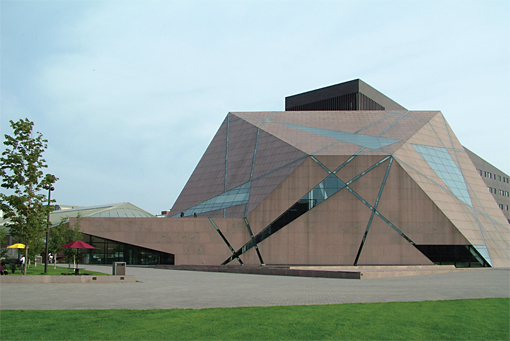| 제목 | [DAIKIN] HIGHER EDUCATION - UofM Alumni Center | 작성일 | 16-06-16 13:37 |
| 글쓴이 | 최고관리자 | 조회수 | 3,205 |
본문
CASE STUDY
Higher Education
Name
University of Minnesota McNamara Alumni Center
Location
Minneapolis, MN USA
Facility Size
231,000 ft2 facility
Issue
Supplement the building's original 550-ton centrifugal chiller
Solution
300-ton Daikin Magnitude® chiller
University of Minnesota Alumni Center Saves $13,000 in Annual Utility Costs with Daikin Magnitude Chiller
The showcase McNamara Alumni Center at the University of Minnesota acts as a visitor center, office building and event center on the Minneapolis campus. With a striking granite-covered, geode-shaped exterior and impressive 85-foot atrium, the structure is a new landmark on the East Bank gateway to the campus. Inside the ultra-modern building is an ultra-modern Daikin Magnitude magnetic bearing compressor chiller, providing impressive operating cost savings for the university.
The 231,000-square foot Alumni Center building opened in 2000 before magnetic bearing chillers were available. Another 550-ton chiller with a traditional centrifugal compressor was originally installed in the building. Jon McCombs, operations manager at the Alumni Center, managed by United Properties' Corporate Solutions division, wanted the reliability and redundancy of a second chiller for the building. "I wouldn't recommend any building owner, especially where they have this kind of run time, not to have some redundancy. Yet two of those large, traditional machines wouldn't have fit in our equipment room."
Finding a backup-chiller
The 300-ton Daikin Magnitude chiller was the perfect solution to supplement the building's original machine and was installed in 2006. According to Schwab Volhaber Lubratt, the Daikin representative in St. Paul, Minn., the compact footprint, part-load performance and quiet operation of the Daikin Magnitude chiller was their recommendation to meet the requirements of the Alumni Center with an almost immediate payback on energy savings.
The Daikin 300-ton magnetic bearing compressor chiller was the clear leader to be the back-up chiller, McCombs says. "Weight was one of the first hurdles we had to overcome. The quiet operation of the Daikin Magnitude chiller allowed us to avoid installing it on a housekeeping pad, used to isolate sound, thus greatly reducing the weight and physical foot print." The magnetic bearing compressor weighs a fraction of a typical centrifugal compressor. McCombs adds, "Our previous weight restriction for the open area prior to installing the new chiller was 125 pounds per square foot. We were able to de-rate the remaining area to 100 pounds per square foot and meet the structural engineer's live load requirement."
The compact design of the chiller – at approximately 12 feet by under 48 inches, including the electrical panel – also made a difference, McCombs says. "We had a very tight design. The electrical panel needed to have a three-foot clearance to meet code. We are extremely close to three feet yet have adequate room for service. Given the size and weight of the machine, we ended up with the maximum machine possible as far as shell size and physical weight restrictions."
Another feature in favor of the Daikin Magnitude chiller was the easy integration with the existing Johnson Controls Metasys® building automation system installed in the Alumni Center. The chiller communicates important control and monitoring information to the Metasys system using BACnet®, the standard open protocol developed by ASHRAE, the American Society of Heating, Refrigeration and Air Conditioning Engineers.
Maintenance savings The magnetic bearing compressors of the Daikin Magnitude chiller eliminate the maintenance associated with oil handling equipment. Also, McCombs says the shell and tube design of the Daikin chiller won out over other chillers that use plate heat exchangers for ease of maintenance. "The ease of service and long-term benefit of having a copper tube design over a stainless steel plate heat exchanger means there are no parts to wear out and very few components ever get replaced," McCombs says. He notes that annual maintenance on the Daikin chiller involves inspecting the electrical connections and cleaning the condenser and evaporator tubes with a rotary brush.

Jon McCombs, operations manager at the Alumni Center, has seen annual electrical energy savings of $13,000 since the Daikin Magnitude chiller was commissioned.
Sound sensitivities
Sound was another critical consideration at the Alumni Center given the building is frequently used for sound sensitive events such as meetings and wedding receptions. McCombs noted that the Daikin Magnitude chiller has the quietest sound levels in the industry with sound pressure ratings as low as 77 dBA per ARI Standard 575. McCombs points out that the University of Minnesota Board of Regents regularly uses a board room and other committee rooms on the floor below the mechanical room. "The lower decibel level, particularly the mechanical sound transfer, was a valuable consideration when making the selection," he says.
Magnitude Chiller takes the lead
The Daikin Magnitude chiller was installed in summer 2006 and put into operation in fall 2006, in time for a few 80-plus degree days. Because of the excellent part-load performance of the Daikin chiller— as low as .33 kW/ton IPLV—the unit has gone from being the back-up chiller to being the primary chiller. "The Daikin chiller has functioned as our primary chiller from the time we commissioned it, reducing our seasonal run-time hours on the other chiller by approximately 800 hours," McCombs says. "We use the Daikin chiller about 65 percent of the time on a year-round basis."
McCombs reports the McNamara Alumni Center has already dramatically reduced its electrical usage since the commission of the Daikin chiller. "We've seen a reduction of around $13,200 based on the savings of 169,139 kilowatt hours at a rate of $0.0780 per kilowatt hours when averaging the past three years of energy used."

The 300-ton Daikin Magnitude chiller was selected for the Alumni Center based on its compact footprint, part-load performance and quiet operation.
Based on the continued use of the Daikin chiller on a primary basis during cooler weather, McCombs anticipates the McNamara Alumni Center will continue to see savings of at least $13,000 on an annual basis. Based on the impressive performance of the Daikin chiller to date, McCombs is also developing an automated program to switch between the two chillers to further maximize energy savings.
McCombs is among a growing number of facilities managers around the country who are realizing the benefits of Magnitude, magnetic bearing compressor chillers by Daikin. "The technology of the chiller will only continue to gain momentum and may revolutionize many areas of not only this industry, but countless others," McCombs says.
| 이전글 | [DAIKIN] HIGHER EDUCATION - St Olaf Science Bldg 2016-06-16 | ||
| 다음글 | [DAIKIN] HOSPITALITY - Costanera Center, Tower 2 and Tower 4 2016-06-16 | ||






